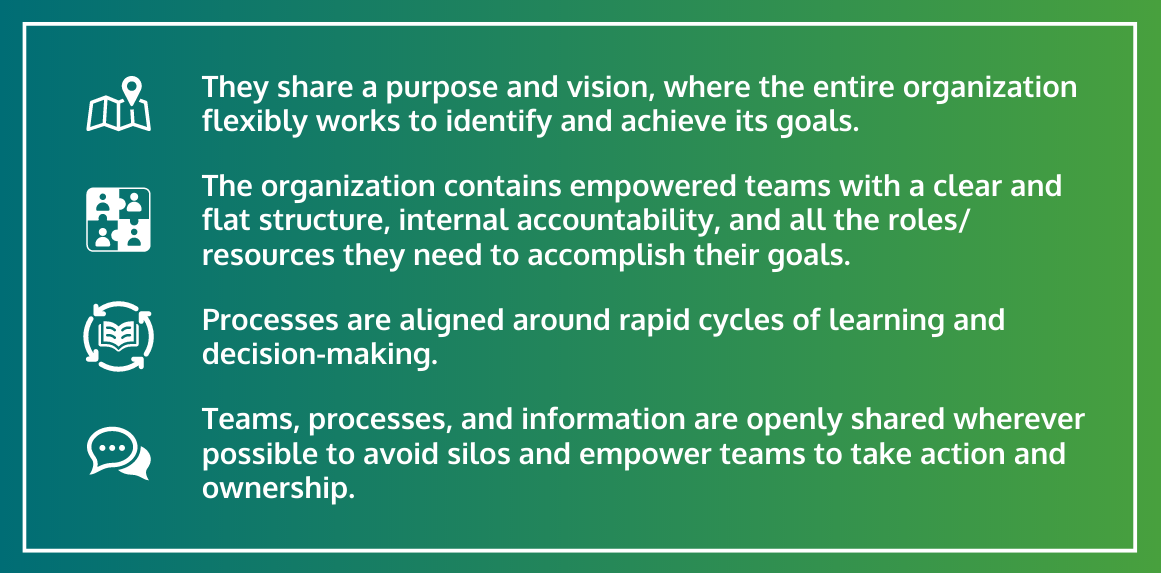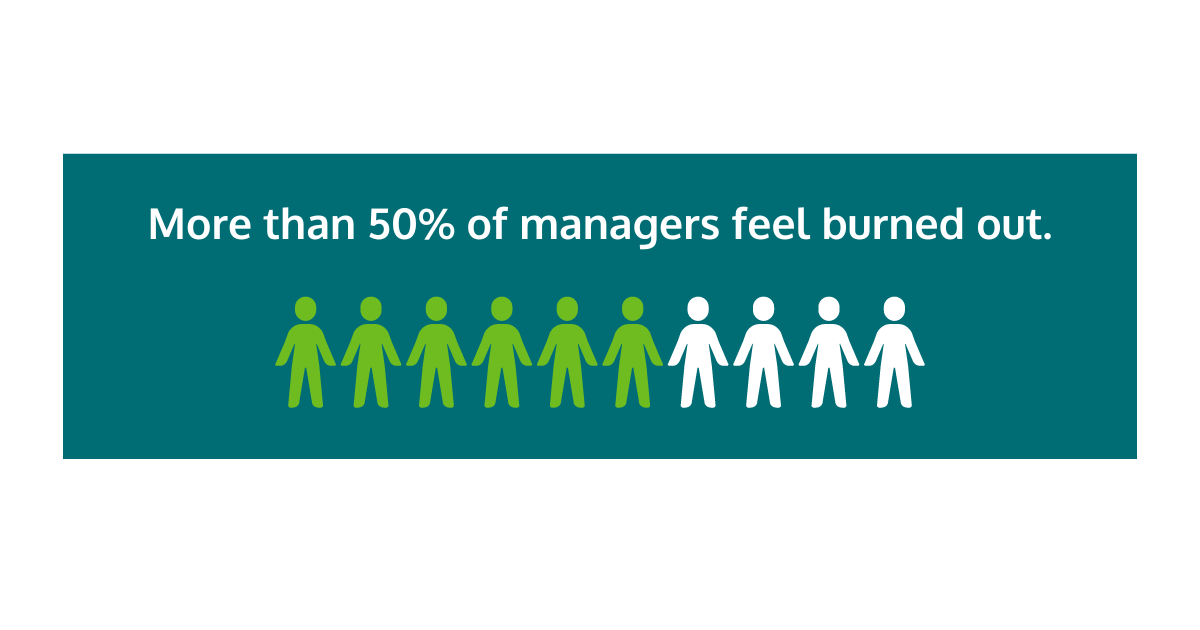Improve your Marketing Ops every week
Subscribe to our blog to get insights sent directly to your inbox.
Confront your process problems head on with a Sherpa by your side.
Explore support options that are tailored to meet you wherever you are on your climb.
Browse our pioneering Agile marketing courses
Learn from the stories of marketers already on the road to process improvement.
Featured Resource

State of Agile Marketing
Learn from 8 years of study on how marketers are increasing their agility.
Download Report
Even people who don’t know much about Agile probably know that it encourages flatter organizational structures. So it’s hardly surprising that many managers end up wondering what Agile adoption will mean for them.
Does Agile mean managers are destined to become obsolete?
Let’s start with the good news: Agile managers still have important roles to play in an Agile organization.
Now the even better news: Agile can help managers address a long list of pain points like lack of transparency, inefficient processes, and silos. But staying relevant and unlocking all of those benefits begins with understanding how the role of managers evolves in an Agile organization.
The first and most important thing to appreciate about this question is that there isn’t a single answer. Ironically, one of the hallmarks of a truly Agile organization is its flexibility and adaptability. That’s why there can’t be a single rigid definition.
That said, while Agile organizations can have org charts that look quite different, they do share some characteristics.

For managers, this means that while individual teams need to have relatively flat structures, there’s still a critical role in tying the work of those teams into a broader strategic vision. There’s also the importance of ensuring information moves freely from teams up to leadership and vice versa.
Ironically, all of this means that managers in an Agile organization can have a clearer and more vital role than in a traditional one. But to really understand that role, let’s begin by examining the problems with managers in traditional organizations.
Most managers are used to their roles focusing mostly on command and control. Days are spent giving instructions and keeping everything on track. For many managers, this can quickly feel exhausting because it creates a culture of dependence where team members feel they need to ask for permission constantly.
It’s hardly surprising that more than 50% of managers feel burned out.

The traditional approach to management is a lose-lose. Managers lose by being overburdened, while the people they manage lose by not being given the autonomy they need to actually do their jobs.
Team members might think that shifting responsibilities to managers takes the pressure off of them, but the reality is that being managed this way both hurts their productivity and limits their freedom to take action on their own. The result is teams that are less effective, and at the end of the day being on a team that can’t accomplish its goals does not feel good.
Traditional management was developed to tackle the problems of 19th-century factories. Today, managers need to manage something radically different: knowledge work. It’s no wonder traditional management styles are leaving many worried they are becoming obsolete. The reality is that Agile doesn’t make all managers obsolete, just traditional managers.
Agile management is vital for Agile organizations.
Today’s managers need to shift their attention toward empowering knowledge workers to be more effective instead of commanding and controlling them as if they’re producing widgets in a factory.
When knowledge and information are what drive success, managers’ focus should be on creating transparency, facilitating the movement of information, and generally finding ways to enhance their team’s effectiveness. That process starts with rethinking the relationship between managers and their employees.
As mentioned earlier, one of the greatest fears many managers have about Agile is the prospect that flattening structures will make them obsolete. The reality is that flatter teams merely mean that managers need to see employees as partners rather than simply people to be managed.
This kind of Agile management ensures employees feel comfortable sharing ideas, feedback, and working together to find better solutions to problems instead of simply turning to their managers to figure things out.
Of course, this all sounds great in theory, but what practical changes need to happen for this new management approach to happen?
Before proceeding to learn about the role of manages in Agile marketing, take a moment to explore The Agile Marketing Credo — the new foundation for how modern marketers work with clarity, focus, and impact.
It’s clear that the primary role of an Agile manager is empowerment, but what does that look like in practice?
Agile marketing strategies require the free movement of input and information between senior leaders and the people executing.
Leaders provide strategic vision while teams determine the best way to execute that vision.
Managers form a critical link between the two, ensuring both that vision and on-the-ground realities are understood at all levels.
Even the best-performing marketing team can quickly get bogged down when it’s bombarded with unplanned work requests. Managers need to be there with a strong understanding of their marketing teams’ objectives, ensuring that only work that contributes to those objectives gets prioritized.
In this way, Agile managers protect their team from overburden and distractions. Teams are able to focus on the most value-adding assignments for the Agile organization.
Lastly, Agile management requires leaders to model the kind of Agile culture they want to see in the organization.
One of the most effective ways to build a strong Agile culture is through leading by example. Instead of simply telling team members to adopt an Agile mindset and approach, showing one in action makes it easier to understand its benefits and to follow along.
In addition, they should be investing in Agile skills through training and tools, and generally helping guide teams to uncover the best way to apply Agile to their specific needs.
Before you take a look at the typical day of an Agile manager, why don't you take a moment to get the most recent State of Agile marketing report?
Marketing managers working in traditional organizations usually spend their time: following up on progress, checking status against deadlines, assigning and delegating work, and constantly answering questions about how things should be done.
They end up buried in details, struggling to stay on top of things.
Team 1:1s end up wasted on reviewing work or approving requests.
The result is managers who are so focused on the tactical aspects of their work they have virtually no capacity to think about strategy, let alone their team’s well-being, growth, or development.
This is the status quo behind so much of the burnout marketing managers face.
Switching over to the daily life of a marketing manager in an Agile organization, things look quite different. Early on, some feel obsolete because the kind of “managing” they are used to doing isn’t really necessary. No one knocks on their door to ask “what should I do next?” anymore, because they already know.
This is where the opportunity to switch from a focus on day-to-day operations towards thinking about delivering benefits to the businesses and customers your team serves opens up. It’s a chance to become more strategic, guiding teams, joining in on why initiatives are important, how value is measured, and saying “no” to the random requests that kept your team permanently scrambling before.
Now, when managers check in with their direct reports they can talk about their professional development and growth instead of tackling a backlog of approvals.
Agile management means they have more time to listen and really understand the challenges their team members face. This enables marketing managers to spend more time finding better tools, courses, and other resources to empower their teams.
Instead of saying, "Well, that's just the way it is," they can get actively involved in smoothing out processes. They can spend time communicating with stakeholders to create a mutual understanding of what value for the business and customers look like. And, if they’re really ambitious, they can work on conveying why the insanity of urgent requests with conflicting priorities has to stop. Finally, Agile managers get major bonus points if they become an advocate for skills development with HR.
These Agile managers can find new purpose in value and people enablement instead of mere management. This is because when you give employees the space to solve problems, seek solutions, and bring their knowledge to life, you quickly learn why you hired them in the first place.
You don’t hire people to be "managed", but to use their skills to create better solutions that hit the spot with customers.
Employees don't need managers, they need enabling leaders.
Now that you have a firm understanding of how important the role of Agile managers is in an Agile organization, you can appreciate how much this role requires rethinking day-to-day work.
That’s why the best way to begin that transformation is with great Agile education.
We offer self-paced and in-person courses on Agile marketing leadership, meaning you can start your journey to Agile with confidence.
Not sure how ready you are for an Agile transformation? Find out with our dedicated checklist on the topic:
Subscribe to our blog to get insights sent directly to your inbox.
Subscribe to our blog to get insights sent directly to your inbox.